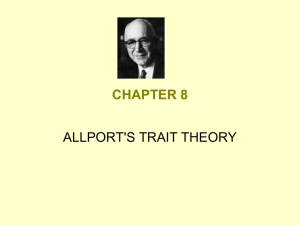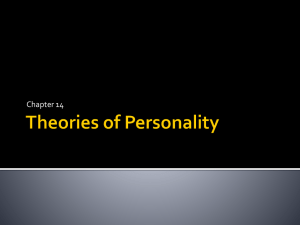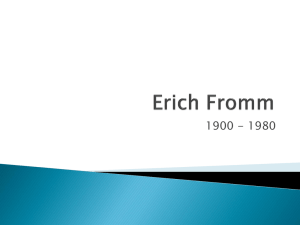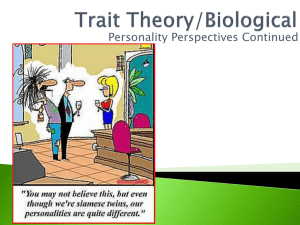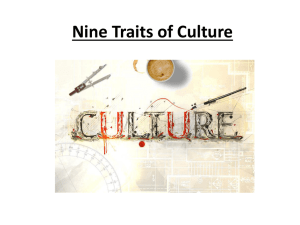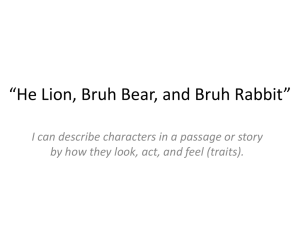Trait Theory/Biological - Mounds View School Websites
advertisement
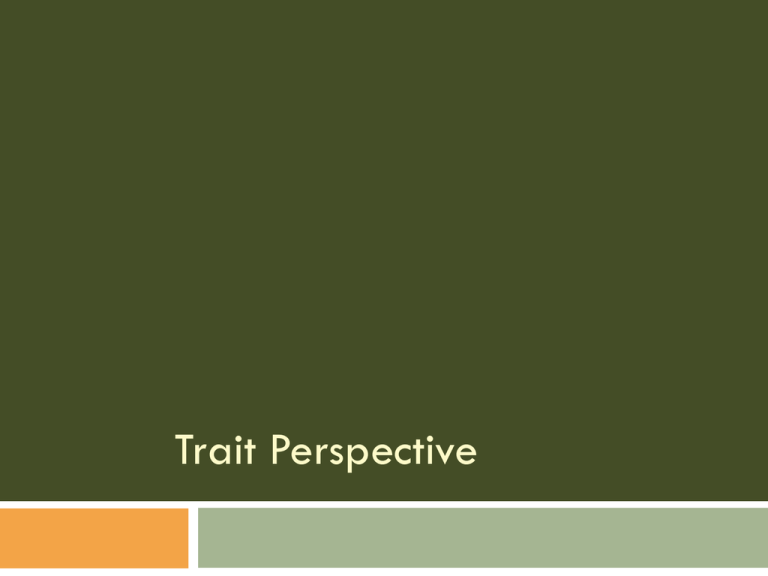
Trait Perspective The Self-Serving Bias A readiness to perceive oneself favorably. People accept responsibility for good deeds more often than for bad People see themselves as better than average Self-Presentation Theory Individualism vs. Collectivism Individualism: Giving priority to one’s own goals over group goals and defining one’s personal attributes rather than group identifications (Independence) Collectivism: Giving priority to the goals of one’s group and defining one’s identity accordingly (Interdependence) Value Contrasts Between Individualism and Collectivism: Page 413 Concept Individualism Collectivism Self Independent Interdependent Life Task Discover and express one’s uniqueness Maintain connections What matters Me- personal achievement We- group goals and solidarity Coping Method Change reality Accommodate to reality Relationships Many, often temporary and casual Few, close and enduring Attributing Behavior Behavior reflects one’s personality and attitudes Behavior reflects social norms and roles Morality Defined by individuals (selfbased) Defined by social networks (duty- based) Take out your books! Open to page 406 Answer questions 9-13 Follow the directions! You will see pictures of 3 different men. On a piece of paper please respond to the following questions/prompts. 1. 2. 3. Choose a name for the person in the picture. Create a list of 5 personality traits you think may be used to describe the man in the picture. What kind of job might this many have? Name and describe this man Name and describe this man Name and describe this man William Sheldon-Somatotypes William Sheldon-Somatotypes William Sheldon- Somatotypes William Sheldon-Somatotypes 1940s’s study of 4,000 college aged men Developed a theory that there are three basic body types, or somatotypes Endoderm Mesoderm Ectoderm There is a correlation between physique and temperament Does this idea seem plausible? Does body type dictate temperament? To what extent does body type influence personality development, if at all? Trait Theory Focuses on identifying and measuring personality characteristics. How many traits are there? In the 1930’s there were 4,500 traits in 1990 it has been reduced to 5. Traits are relatively stable characteristics that causes individuals to behave in certain ways. Focuses on differences between individuals. Gordon Allport’s Trait Theory Cardinal, Central, & Secondary Allport categorized traits. Cardinal Traits that dominate an individuals whole life. Consider the origins of the following terms Freudian, Don Juan, Christ-like Rare and tend to develop later in life. Gordon Allport’s Trait Theory Cardinal, Central, & Secondary Central Traits: The general characteristics that form the basic foundations of personality. Major characteristics you might use to describe another person. Gordon Allport’s Trait Theory Cardinal, Central, & Secondary Secondary Traits: Traits that are sometimes related to attitudes or preferences Often appear only in certain situations or under specific circumstances. Personality Not Included What are the 5 main traits that make up personality? Activity! Handout 18-6 Reverse scores 1=5 2=4 3=3 4=2 5=1 Five-Factor Model (Big 5) OCEAN Mnemonic device Organizes all personality traits into 5 categories. Five-Factor Model (Big 5) OCEAN Mnemonic device Five-Factor Model (Big 5) OCEAN Mnemonic device Add numbers for 1, 7, 13, 19, 33, 39, 46, 49, 53 Five-Factor Model (Big 5) OCEAN Mnemonic device Add numbers for 2, 8, 15, 25, 28, 34, 40, 45, 51 Five-Factor Model (Big 5) OCEAN Mnemonic Device Big 5 Model Raises 3 Issues Is our behavior stable and consistent? PERSON –SITUATION CONTROVERSY Personality traits are both changeable and stable. Most change occurs before age 30 Most stability occurs after age 30, but adults do continue to grow in their ideas, beliefs & attitudes. Genetic Factors may push and pull the development of certain traits, whose development may be helped or hindered by environmental factors. Hans Eysenck and Sybil Eysenck Take out your books! Open to page 406 Answer questions 9-13 Correct Answers: 9. c 10. b 11. c 12. c 13. c
